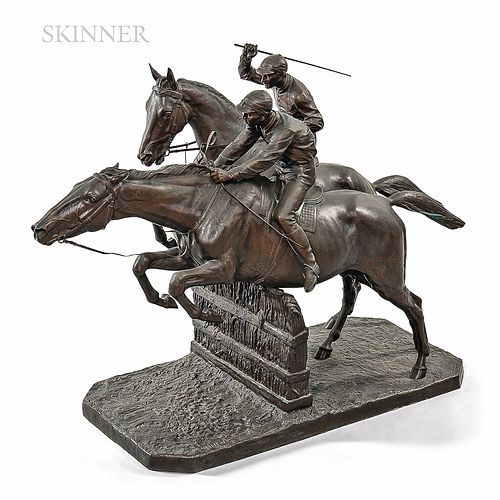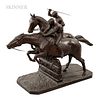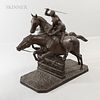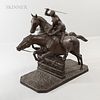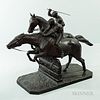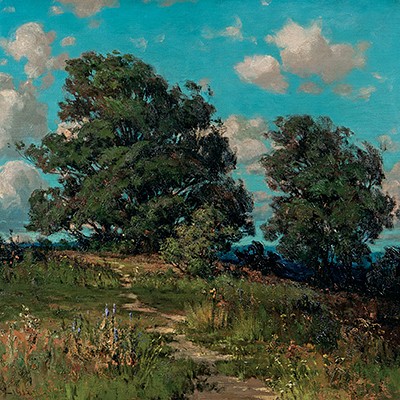Isidore Jules Bonheur (French, 1827-1901) The Steeplechase
Lot 28
About Seller
Bonhams Skinner
274 Cedar Hill Street
Marlborough, MA 01752
United States
Founded over four decades ago, Bonhams Skinner offers more than 60 auctions annually. Bonhams Skinner auctions reach an international audience and showcase the unique, rare, and beautiful in dozens of categories, including the fine and decorative arts, jewelry, modern design, musical instruments, sc...Read more
Categories
Estimate:
$80,000 - $120,000
Absentee vs Live bid
Two ways to bid:
- Leave a max absentee bid and the platform will bid on your behalf up to your maximum bid during the live auction.
- Bid live during the auction and your bids will be submitted real-time to the auctioneer.
Bid Increments
| Price | Bid Increment |
|---|---|
| $0 | $10 |
| $100 | $25 |
| $500 | $50 |
| $1,000 | $100 |
| $3,000 | $250 |
| $5,000 | $500 |
| $10,000 | $1,000 |
| $30,000 | $2,500 |
| $50,000 | $5,000 |
| $100,000 | $10,000 |
| $300,000 | $25,000 |
| $500,000 | $50,000 |
| $1,000,000 | $100,000 |
About Auction
By Bonhams Skinner
Sep 25, 2020
Set Reminder
2020-09-25 12:00:00
2020-09-25 12:00:00
America/New_York
Bidsquare
Bidsquare : Fine Paintings & Sculpture
https://www.bidsquare.com/auctions/skinner/fine-paintings-sculpture-5569
The auction covers a broad range of Western styles, media, and regions from the 16th century to the present day including paintings, sculpture, and works on paper Bonhams Skinner bidsquare@bonhamsskinner.com
The auction covers a broad range of Western styles, media, and regions from the 16th century to the present day including paintings, sculpture, and works on paper Bonhams Skinner bidsquare@bonhamsskinner.com
- Lot Description
Isidore Jules Bonheur (French, 1827-1901)
The Steeplechase
Signed "I. BONHEUR" on the top of the base at the front, incised with the foundry notation "H. Peyrol. F. bt (Paris)" along the back edge of the base.
Bronze with a dark brown patina, height 35 1/2 in. (90.2 cm).
Condition: Stirrups on outside legs of each rider are loose, some irregular brush marks of darker color in the patina to the inside flank and back of the saddle of the horse on the left, dust and dirt to interstices, minor wear to patina on the muzzle of the horse on the left, rein on horse on left possibly detached and crop may be slightly bent.
Provenance: The collection of Joseph Thomas Alvarez III, California.
Literature: Christopher Payne, Animals in Bronze: Reference and Price Guide (Woodbridge, Suffolk: Antique Collectors' Club, 1986), p. 345.
N.B. The younger brother of Rosa Bonheur, Isidore Bonheur was a prominent sculptor and animalier in his own right. He began studying painting with his father, but by 1848 he discontinued working in oil in favor of sculpture, enrolling at the École des Beaux Arts in 1849. He is widely recognized for his small bronze groups, including sculptures of horses, cattle, sheep, and dogs, and like his sister, Isidore did not sentimentalize his animal subjects. His works were frequently cast by his brother-in-law, Hippolyte Peyrol. Like many nineteenth-century French animaliers, Bonheur found that the market for his works was stronger in Britain.
This large double steeplechaser bronze has been described by Christopher Payne as "...one of the finest and largest groups in the animalier field." (Animals in Bronze, p. 345). Unusual and ambitious in scale, the sculpture shows the vigorous movement and keenly observed detail characteristic of the artist at his best.
Estimate $80,000-120,000
Small abrasion on the boot of the right hand rider. Drips of a natural resin substance on the right flank and on the saddle of the left hand horse. Dust and dirt overall.
The horses and riders are beautifully balanced, resting on only two spots on the fence. The sculpture has its historic patina intact.
Items may have wear and tear, imperfections, or the effects of aging. Any condition statement given, as a courtesy to a client, is only an opinion and should not be treated as a statement of fact. Skinner shall have no responsibility for any error or omission. - Shipping Info
-
Please visit http://www.skinnerinc.com/services/payment-and-shipping/ for information regarding the collection of items purchased at auction.
-
- Buyer's Premium



 EUR
EUR CAD
CAD AUD
AUD GBP
GBP MXN
MXN HKD
HKD CNY
CNY MYR
MYR SEK
SEK SGD
SGD CHF
CHF THB
THB